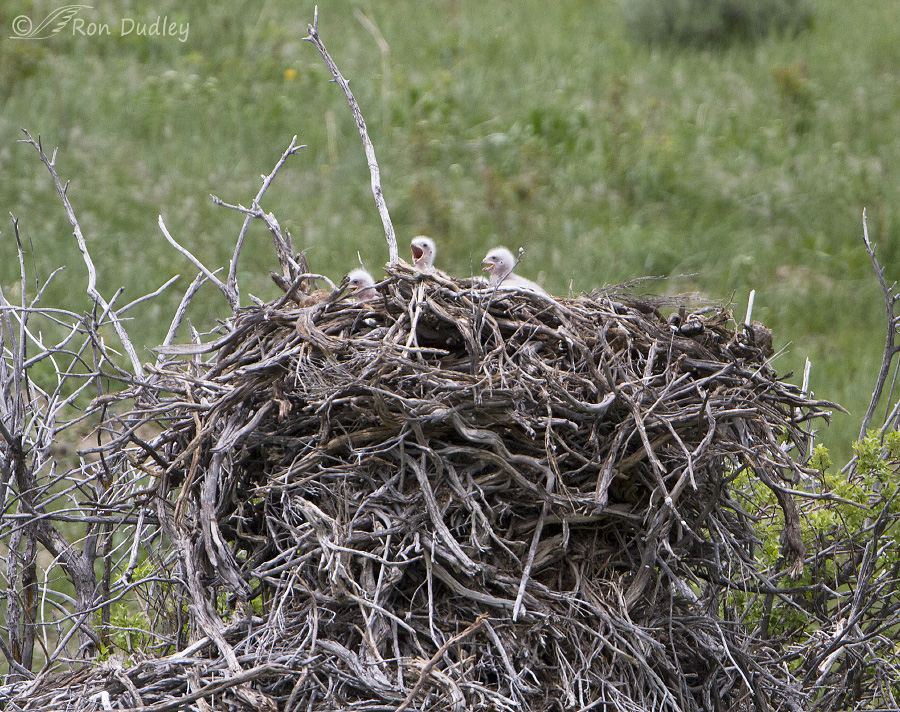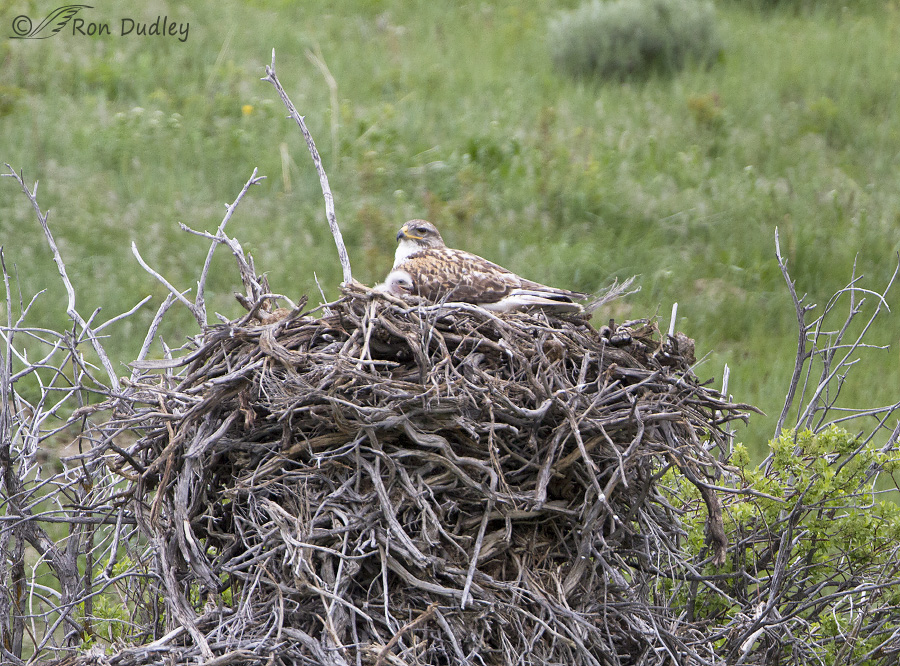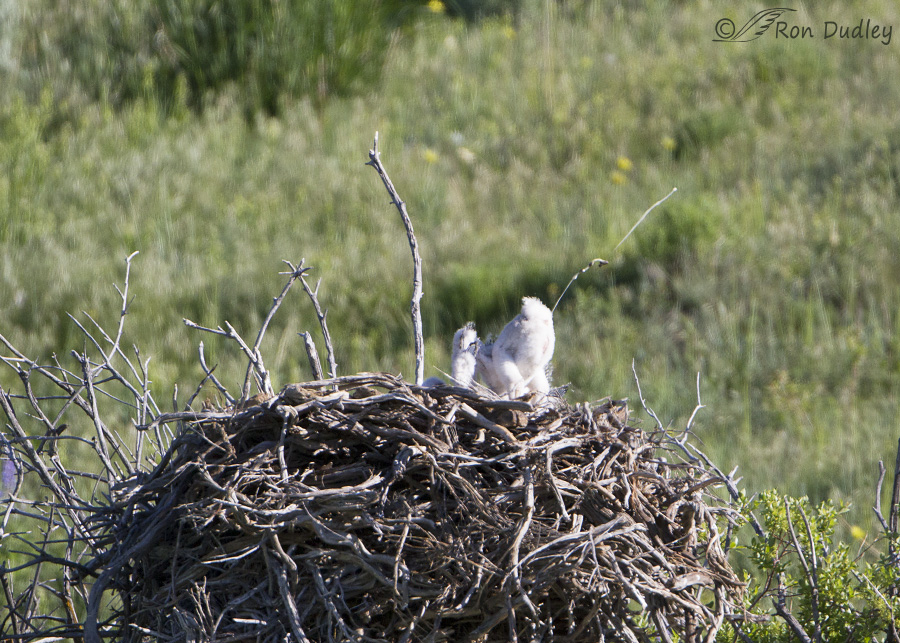A recent article in High Country News brought back many fond memories of photographing Ferruginous Hawks in Montana.
The High Country News used this image of mine in a comprehensive article about Ferruginous Hawks (written by Maya L. Kapoor) in their March 6 issue of the magazine. It’s a wonderfully written tribute to Ferruginous Hawks but it’s more than that – much more. The article discusses the rewards and challenges of using un-releasable raptors as education birds and the value of and controversies involved with rehab facilities that nurse injured wildlife back to health. If you’re a subscriber to the magazine (hard copy or online) I’d highly recommend that you read the thought-provoking article and if you’re one of the many wildlife rehabbers who follow my blog I’d be interested in your thoughts about Kapoor’s take on raptor rehabilitation.
Maya, a 12 year old female Ferruginous Hawk who fell out of her nest in Montana as a fledgling, is the centerpiece of the article. Maya is now used as an education bird in the Raptor Free Flight program at the Arizona-Sonora Desert Museum outside of Tucson.
I received my complimentary copy of High Country News a few days ago and reading the article and seeing my image again brought back a flood of memories of my experiences with Ferruginous Hawks, particularly in Montana (the nest above was in Beaverhead County, MT), so I thought I’d include two more images taken at that nest back in June of 2013.
Here one of the adults is shading the chicks in the nest from the hot sun (I took the photo when one of them popped out for a moment to investigate its surroundings). This nest was absolutely massive – so much so that it reminded me of an eagle’s nest.
- It’s important to note that nesting Ferruginous Hawks are notoriously sensitive to human intrusion and may abandon the nests and/or chicks if they’re disturbed. I took these photos from inside my pickup on a public road with a supertelephoto lens at an effective focal length of 1120mm and the photos were cropped significantly. The hawks were acclimated to traffic on the road. I would never approach or disturb nesting raptors of any species but Ferruginous Hawks in particular.
I thought I’d “end” with an image that might make readers smile. Here one of the chicks is forcefully ejecting feces far from the nest – a behavior common to many raptor species as a sanitation device to keep the nest clean. This photo was taken 10 days after the previous one – note how much the chick has grown in that relatively short time.
High Country News is a highly respected publication that I suspect some of my readers subscribe to. This from Wikipedia:
- High Country News is a non-profit news media source, publishing a magazine, a popular website and a weekly op-ed column service, along with special reports and books. The organization covers the American West’s public lands, water, natural resources, grazing, wilderness, wildlife, logging, politics, communities, growth and other issues now changing the face of the Western United States.
If you’re a subscriber I highly recommend that you read the article. Here’s a link to it but you must subscribe or sign up for a free trial before you can see most of it.
Ron





Just a few comments beyond the regular string of ridiculously redundant superlatives.
I LOVE HCN and have been a subscriber for years, even while living in NY. That said, not sure when I’ll have time to read that article, although it’s at the top of the enormous heap of to-do things.
I’m sure you know that Ferrugs are thought of as small booted eagles, hence the size of the nests! But Redtail nests ain’t that shabby in terms of size, either.
I love that raptors just know how to slice (poop stream) outside the nest and do it from their first slice onward (albeit not necessarily always successful in the first attempt right out of the egg). I’m SURE human parents would appreciate this particular skill
Laura, when I used to have education raptors brought into my Zoology classes they’d usually be on a perch on top of my preparation table. I’d draw a target with a bullseye on my blackboard right behind the perched birds and my kids got a helluva kick out of how close a “slice” would come to hitting the target. Usually they were low but a few of them really “spit it out”…
LOL Ron! Those first-thin-in-the-morning slices from a female redtail are impressive! I’m truly whelmed with those, and often overwhelmed! Don’t ever stand behind a lifted tail! LOL!
I can’t think of a better way to illustrate the old phrase ‘better out than in’ than your final photo.
And hooray for rehabbers and educators. All of them.
They have my heartfelt appreciation too, EC. I’m unaware of a more hardworking and selfless group of people anywhere and they’ve bailed me out of some ticklish situations more than once.
Congratulations upon another published photograph! The last shot did, indeed, elicit a chuckle. The chicks bring an easy smile, what with all their downy fuzziness. As my students would say, very sqee-worthy.
I’ve always marveled at the complexity and construction of birds’ nests. This one is no exception.
Marty, when there were no birds to be seen at the nest I often spent time looking at (and marveling over) that huge pile of sticks and branches through my lens.
Very thoughtful article, Ron. The author has an interesting mix of experiences to bring to the issue. I agree with her on the impact that a positive action can take – be it rescuing an individual wild animal or a Boy Scout building a nest platform. In today’s world where armchair nature experiences can be had on any digital device – while maintaining a distance in time and place – something like this is essential. She doesn’t really reach a personal conclusion about rehabilitation, I don’t think – in my mind, rehabilitation without education is kind of a dead end in terms of changing habits, though not obviously for the animal itself. As she says, the finder feels like they’ve done something by bringing in the animal but then likely goes back to whatever s/he was doing that caused the problem in the first place.
I may have shared this with your readers before – but here’s a link to an article I wrote some 17 years ago about the value of wildlife rehabilitation. Our criteria for keeping non-releasable animals in human care for education has evolved, however – trying to avoid a lifetime of just ‘a bird in a box’ (no matter how big the box is and our aviaries are large), by careful assessment of temperament, quality of life, long term impact of the injuries that made the bird non-releasable. We provide enrichment and training and stimulus wherever we can.
Our criteria for keeping non-releasable animals in human care for education has evolved, however – trying to avoid a lifetime of just ‘a bird in a box’ (no matter how big the box is and our aviaries are large), by careful assessment of temperament, quality of life, long term impact of the injuries that made the bird non-releasable. We provide enrichment and training and stimulus wherever we can.
http://cascadesraptorcenter.org/articles/what-good-is-wildlife-rehabilitation. Just rereading it, I still totally agree with myself!
I think the free flight show at the Arizona Sonora Desert Museum is the best I’ve seen. We don’t have that kind of wide open spaces here in the woods, but having visitors watch our interactions and training sessions has had a big impact on them, as they report – it allows us to go beyond them simply seeing a bird and not learning much about what they can do to prevent the next bird from coming into the clinic.
Thanks so much for your feedback on the article, Louise. I was hoping you’d weigh in on it. I liked most everything Kapoor said about rehab and education but was really interested in your take and that of any other rehabbers that might care to comment.
And isn’t it nice to still “totally agree with yourself” after all these years!
Very interesting article. Thank you for your work in both rehabilitation and education.
And no, Louise, I don’t recall seeing your article previously so I’m glad you provided the link. It is nothing short of excellent!
Thanks, Ron! Nice to hear that from someone I respect so much.
A very interesting article…thanks for providing it. Since our species are so intrusive and detrimental to others we supposedly share this planet with, I feel its our duty to atone at least somewhat at least by helping other species when in trouble. I hope those who feel as that gentleman did about the GHO being rehabbed doesn’t seek mediclal help if he has heart attack, other illneess, in an accident or hsve someother illness or medicsl problem. We have far too msny humans as it is, and they are proving to be extremely detrimental to other species…even to themselves….
I did not realize Ferruginous hawks were so sensitive. Thx for that info. I’ll check out the article.
My 600 went soft on me yesterday. I will be spending the day trying to confirm whether it was operator error or something is amiss. I changed my settings in case three prior to this shoot of a GBH, BN Stilts and Immature American avocets on the water, but I was shooting with single point AF so that should not make a difference, at least I would think. I will change them back to where they were and see. I just can’t believe changing the tracking sensitivity to minus would have an impact for birds standing in the water. Several of the images in DPP4 did not show the active AF point, but those that did were also soft. If fact, every shot was soft. Hope I can clean it up today, but otherwise it might be going in for service. If you have any thoughts on this it would be appreciated.
As always, it’s nice to share my coffee with you.
I wish I could help you out, Frank, but as you know these lenses are incredibly complex machines and the list of things that can go wrong is endless. I know your frustration all to well and wish you the best of luck!
The Arizona-Sonora Desert Museum is one of my favorite places. We haven’t visited in several years, but the Raptor Free Flight program sounds like it would be well worth seeing. I am glad to report that they are not the only place that lets their raptors fly free. We’ve been multiple times to the raptor show at the Jurong Bird Park in Singapore, and one of the things that is great about that show is that the birds do fly free. But that show is in an amphitheater setting. I would love to see that kind of show in the open desert.
I’ve yet to visit the ASD Museum, Susan. I’d like to some day…
Massive is a good word for their nest, a lot like an old Eagle nest I once observed for two years that interestingly was used by Ospreys after the nest seemed to be abandoned.
Good article, but, will the uninitiated to natural history, to raptors and birds in general read it. The more urbanized we become the more people seem to be removed from understanding the natural system. Sorry, I try to be optimistic, but sometimes its tough.
Dick, I agree that the target audience of the article is probably largely folks who already have an appreciation for the natural world but I still think it will have at least some influence in the general population. Every little bit helps.
I was thrilled to read Maya’s article on Hyla, the Ferruginous Hawk, at ASDM’s Raptor Free Flight. Amazing mix of facts and personal experiences that speak to many challenges facing our environment. For me working with the folks at RFF and talking about the birds’ gifts and challenges has been extraordinarily significant to my life. Ron, keep up your good work. You have a large impact on many people.
Carroll, I thought the article was thoughtfully written and very helpful in understanding some of the natural history of the species and some of the subtle implications of wildlife rehabilitation and using raptors as education birds.
Wonderful images, Ron! That nest looks like one GHO’s or Magpies would covet or try to raid for nesting material for their own in the case of the Magpies. Will be checking out HNC
That nest looks like one GHO’s or Magpies would covet or try to raid for nesting material for their own in the case of the Magpies. Will be checking out HNC
Thank you, Judy.
Great images Ron! I love HCN and read every issue.
Good! I figured some of my readers might be fans of HCN.